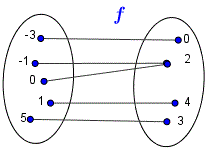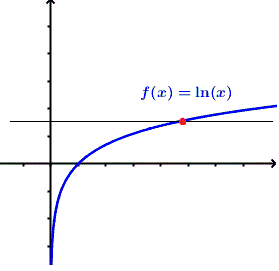Explore the concept of one-to-one function using examples. This concept is
necessary to understand the concept of inverse function definition and its
properties and also to solve certain types of
equations. Several functions are explored graphically using the horizontal line test. Examples of analytical explanations are, in some
cases, provided to support the graphical approach followed here. Some definitions are reviewed so that the explorations can be carried out without difficulties.
More Questions on one to one Functions are included in this website.
One to One Function
Definition of a Function
A function is a rule that produces a correspondence between the elements of two sets: D ( domain ) and R ( range ), such that to each element in D there corresponds one and only one element in R.
Definition of a one-to-one function
A function is a one-to-one if no two different elements in D have the same element in R.The definition of a one to one function can be written algebraically as follows:
Let x1 and x2 be any elements of D
if x1 is not equal to x2 then f(x1) is not equal to f(x2)
Using the contrapositive to the above
if f(x1) = f(x2) then x1 = x2.
In the Venn diagram below, function f is a one to one since not two inputs have a common output.


Horizontal Line Test
If the graph of a function is known, it is fairly easy to determine if that function is a one to one or not using the horizontal line test.The graph in figure 3 below is that of a one to one function since for any two different values of the input x (x1 and x2) the outputs f(x1) and f(x2) are different.


Examples of One to One Functions
Example 1
Show algebraically that all linear functions of the form f(x) = a x + b , with a ≠ 0, are one to one functions.Solution
We use the contrapositive that states that function f is a one to one function if the following is true:
if f(x1) = f(x2) then x1 = x2
We start with
f(x1) = f(x2)
which gives
a x1 + b = a x2 + b
Simplify to obtain
a ( x1 - x2) = 0
Since a ≠ 0 the only condition for the above to be satisfied is to have
x1 - x2 = 0
which gives
x1 = x2
We have shown that f(x1) = f(x2) leads to x1 = x2 and according to the contrapositive above, all linear function of the form f(x) = a x + b , with a ≠ 0, are one to one functions.
Example 2
Show analytically and graphically that the function f(x) = - x2 + 3 is not a one to one functions.Solution
We use the contrapositive that states that function f is a one to one function if the following is true:
if f(x1) = f(x2) then x1 = x2
We start with
f(x1) = f(x2)
which gives
- x12 + 3 = - x22 + 3
Simplify to obtain
- ( x12 - x22) = 0
Factor - ( x1 - x2)( x1 + x2) = 0 which gives
x1 - x2 = 0 or x1 + x2 = 0
which gives
x1 = x2 or x1 = - x2
Since the above test does not strictly conclude that x1 = x2 the function is not a one to one.
Below is shown the graph of the given function and two horizontal lines are drawn: the x axis and the line y = - 2 (broken line) that shows clearly that there are two points of intersections and therefore the function is not a one to one.

Example 3
Show graphically that each of the following functions is a one to one function.1) f(x) = ln(x)
2) g(x) = ex
3) h(x) = x3
Solution
The graph of each of the above functions is shown below with a horizontal line that shows one point of intersection only and therefore all the three functions are one to one functions.
1)



How are One to One Functions Used?
One to one functions are used in
1) Inverse
One to one functions have inverse functions that are also one to one functions.
2) Solving certain types of equations
Examples 1
To solve equations with logarithms such as
ln(2x + 3) = ln(4x - 2)
we deduce the algebraic equation because the ln function is a one to one.
2x + 3 = 4x - 2
Examples 2
To solve equations with exponentials such as
e- x + 2 = e3 x - 8
we deduce the algebraic equation because the ex function is a one to one.
- x + 2 = 3 x - 8
More References and links on or related to one to one functions
Questions on one to one Functionsinverse function definition
properties